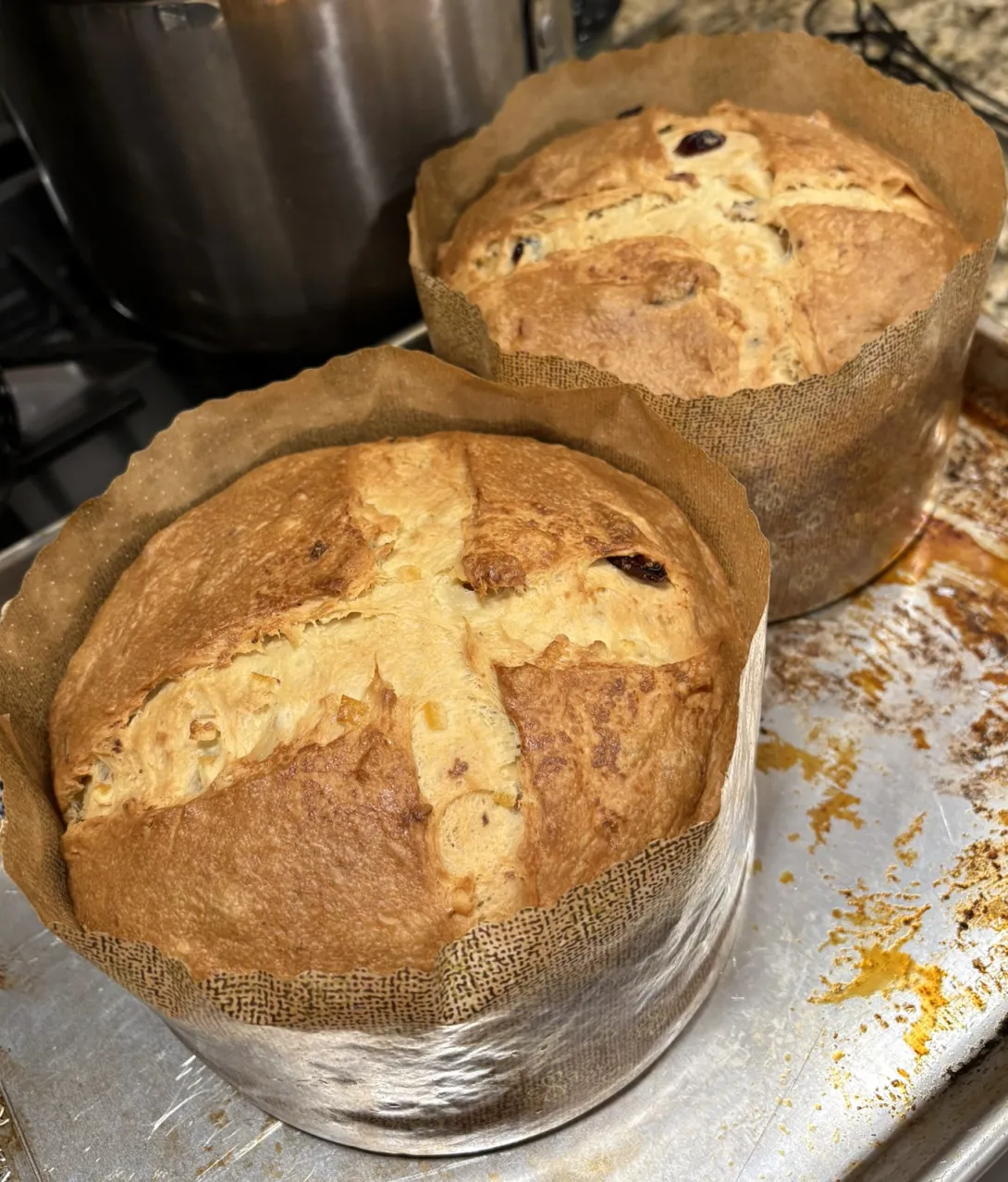
I decided to continue my panettone journey by baking for Easter. There were lots of ups and downs, and I'd love feedback from more experienced folks on where things went wrong. Be ready for lots of pictures.
In the past my issue was with a sluggish and/or overly acidic starter, so I followed the regimen I found here. But below is the full recipe and method I followed. All weights are in grams. All flour is Caputo Manitoba at 14.24% protein, butter is Kerrygold unsalted. Eggs are fresh from locally raised chickens. All rises were in my proofing box set to 77F unless otherwise noted.
First I built a stiff starter from my 100% hydration sourdough starter, which had been recently refreshed. I followed the same regimen at 8am, 4pm, and just before bed for 3 days (it was supposed to be two, but my schedule changed so I just did one extra day of refreshments). The starter easily tripled each time:
| Starter | 15.00 |
| Water | 15.00 |
| Flour | 30.00 |
On the 4th day I did a bagnetto first thing in the morning. Added 3g of sugar to 1L of water, broke the stiff starter in two and let it bob around for 15 minutes. Drained, squeezed it out as best I could, then continued building the lievito madre:
| Starter | 15.00 |
| Water | 15.00 |
| Flour | 30.00 |
| Rest 4 hours in water | |
| Starter | 60.00 |
| Water | 25.00 |
| Flour | 50.00 |
| Rest 4 hours in water | |
| Starter | 135.00 |
| Water | 40.00 |
| Flour | 80.00 |
| Rest 4 hours in water |
Each time the starter was kneaded and rolled into a little chiocciola and put in 80F water, then into the proofing box. After 4 hours it was happily floating every time.
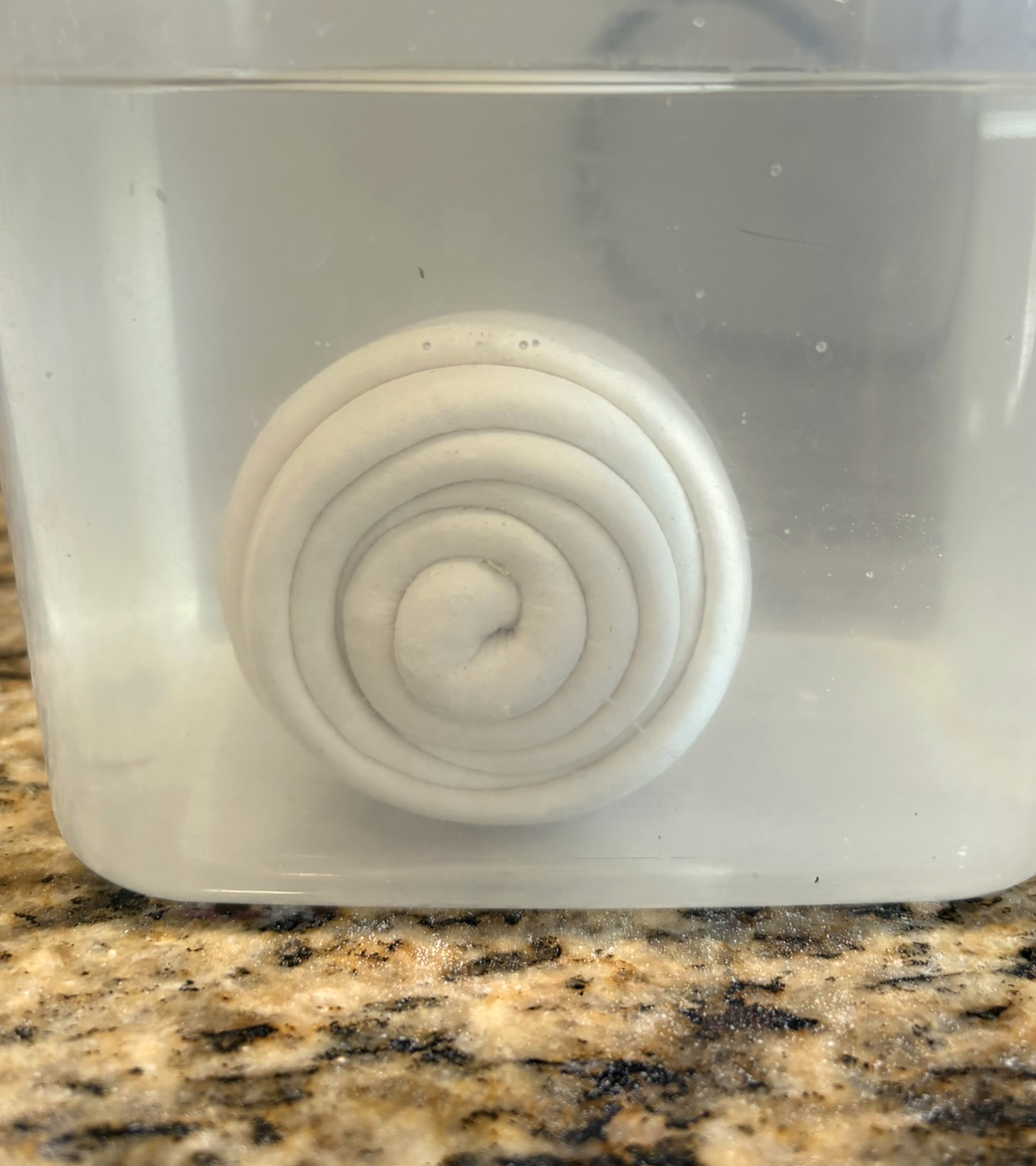
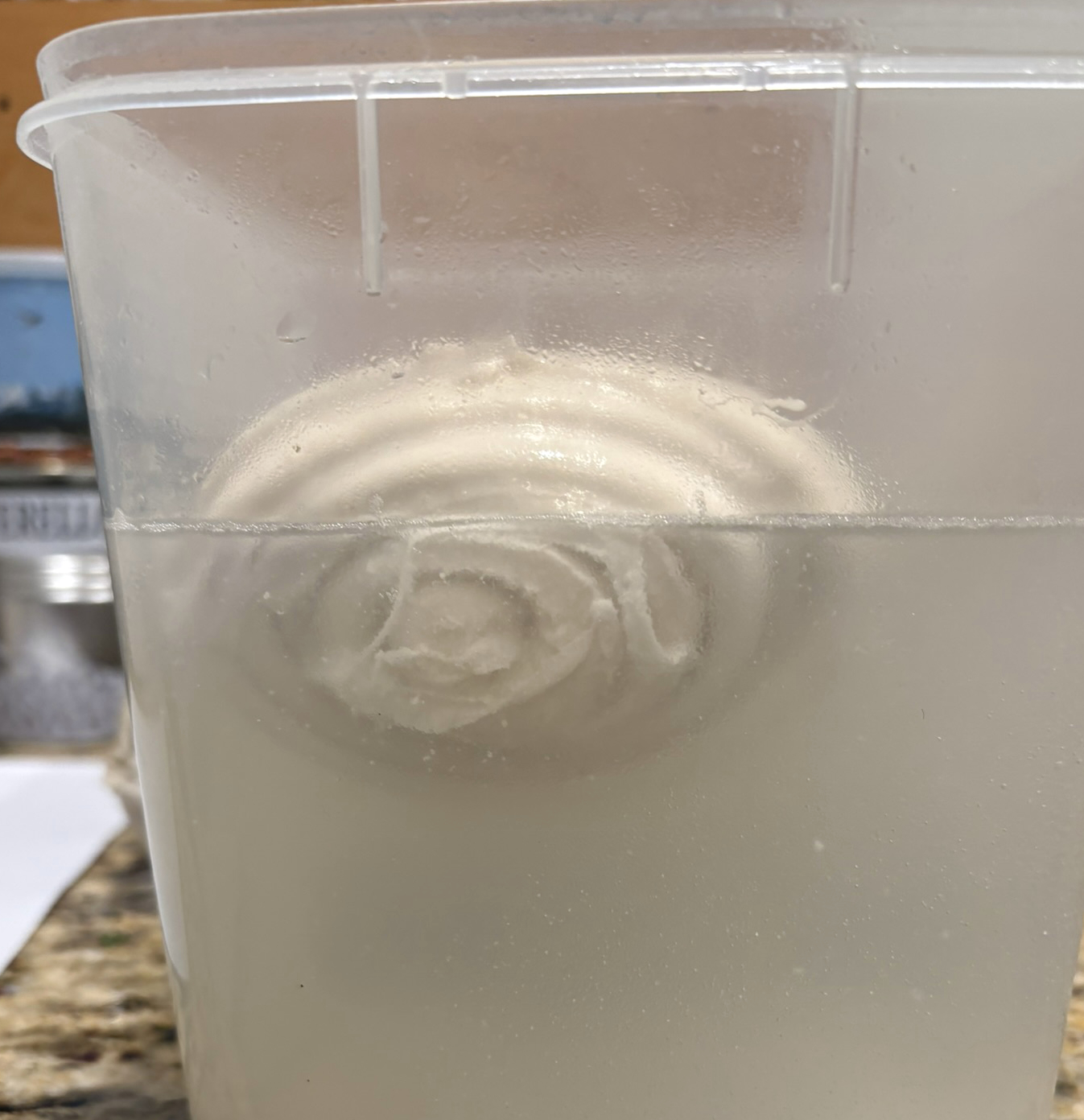
After the last 4 hours, I dumped it into a strainer and started building the first dough.
| First dough | |
| High protein flour | 375.00 |
| Water | 195.00 |
| Sugar | 105.00 |
| Sourdough starter | 105.00 |
| Egg yolks | 97.50 |
| Butter, room temp | 165.00 |
| Subtotal | 1,042.50 |
- Mix flour, water, sugar in Kitchenaid
- Add starter while mixing
- Cream together butter and yolks by hand, add to dough in 3-4 additions
- Knead on speed 2 with dough hook for ~20 minutes
- Finish by hand with slap and folds until it shows a good windowpane
- Put in proofing box for 12 hours until tripled
I didn't get a picture, but it started below the 1L mark on my container. The next morning it was well risen and beautiful, so I got my mise setup for the second dough.
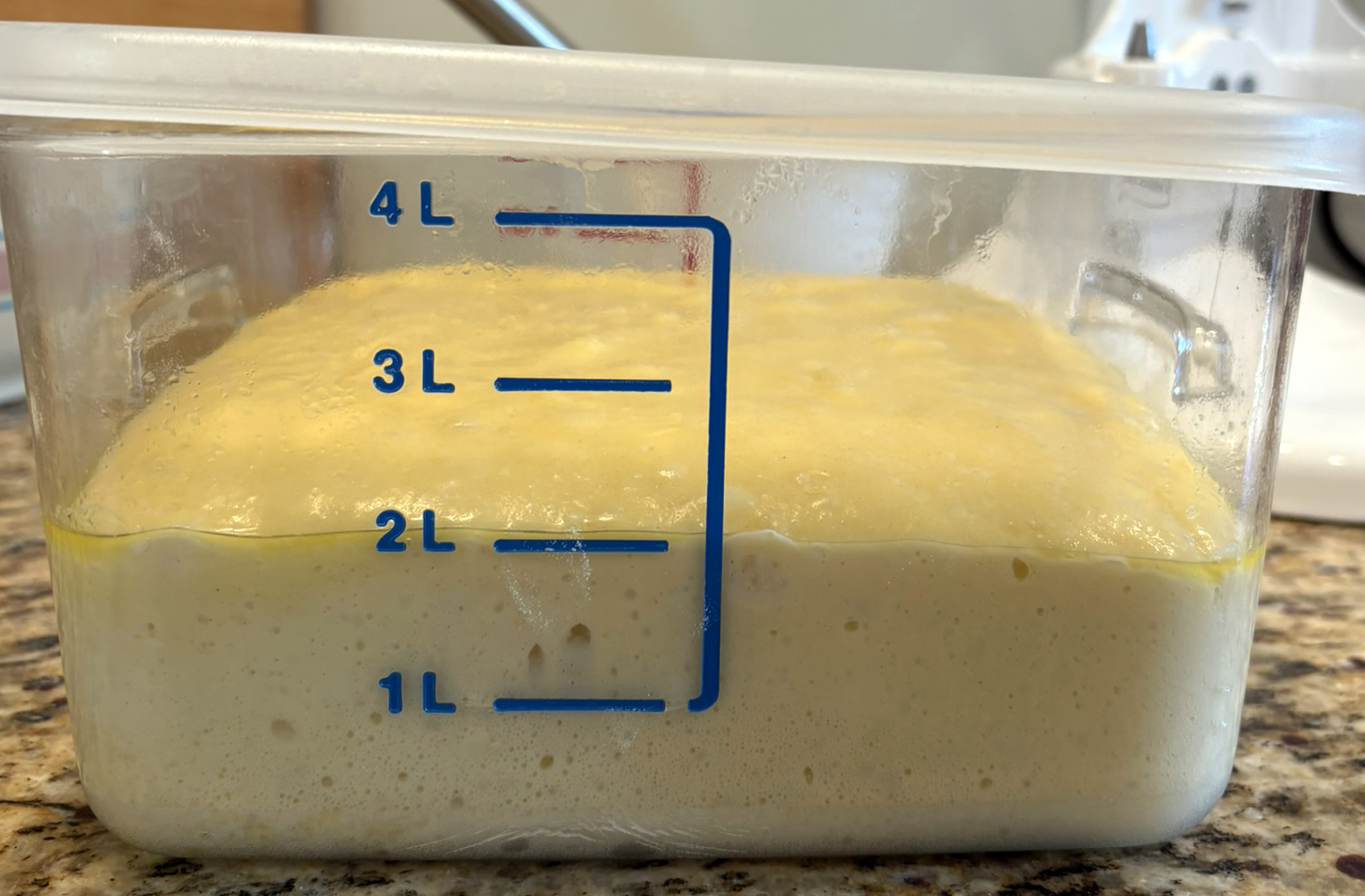

| Second dough | |
| High protein flour | 180.00 |
| Honey | 45.00 |
| Egg yolks | 93.00 |
| Sugar | 120.00 |
| Butter | 180.00 |
| Double strength vanilla | 6.00 |
| Salt | 10.50 |
| Dried fruit, soaked and dried | 270.00 |
| Candied fruit | 270.00 |
| Subtotal | 1,174.50 |
The dried fruit is a mix of raisins, currants, and cranberries, soaked in 1/2 cup bourbon, 1/2Tb lemon extract, 1/2Tb orange extract, 1Tb Fiore di Sicilia, soaked overnight and drained. The extra makes a great snack.
The candied fruit is diced candied bergamot and orange peel from Gustiamo.
- Add flour to first dough
- Cream together butter and yolks by hand, add to dough in 3-4 additions
- Add salt, honey, sugar, vanilla
- Knead on speed 2 for 20 minutes
This is where things started to go wrong. The gluten structure was almost completely gone, and having had this happen before I felt totally defeated.
I decided to crank the mixer up to the "inadvisably fast" setting (I think it was 4? I was delirious by now), and after a few minutes the gluten structure started to return. At this point dough and fruit were literally being fired across my kitchen, so I switched to hand stretch and folds for a while.
That seemed to do the trick, so I shaped them, let them rest on the counter a half hour, then la pirlatura for a final shaping before popping in to the molds and the proofing box for a 6-12 hour rise until tripled again.
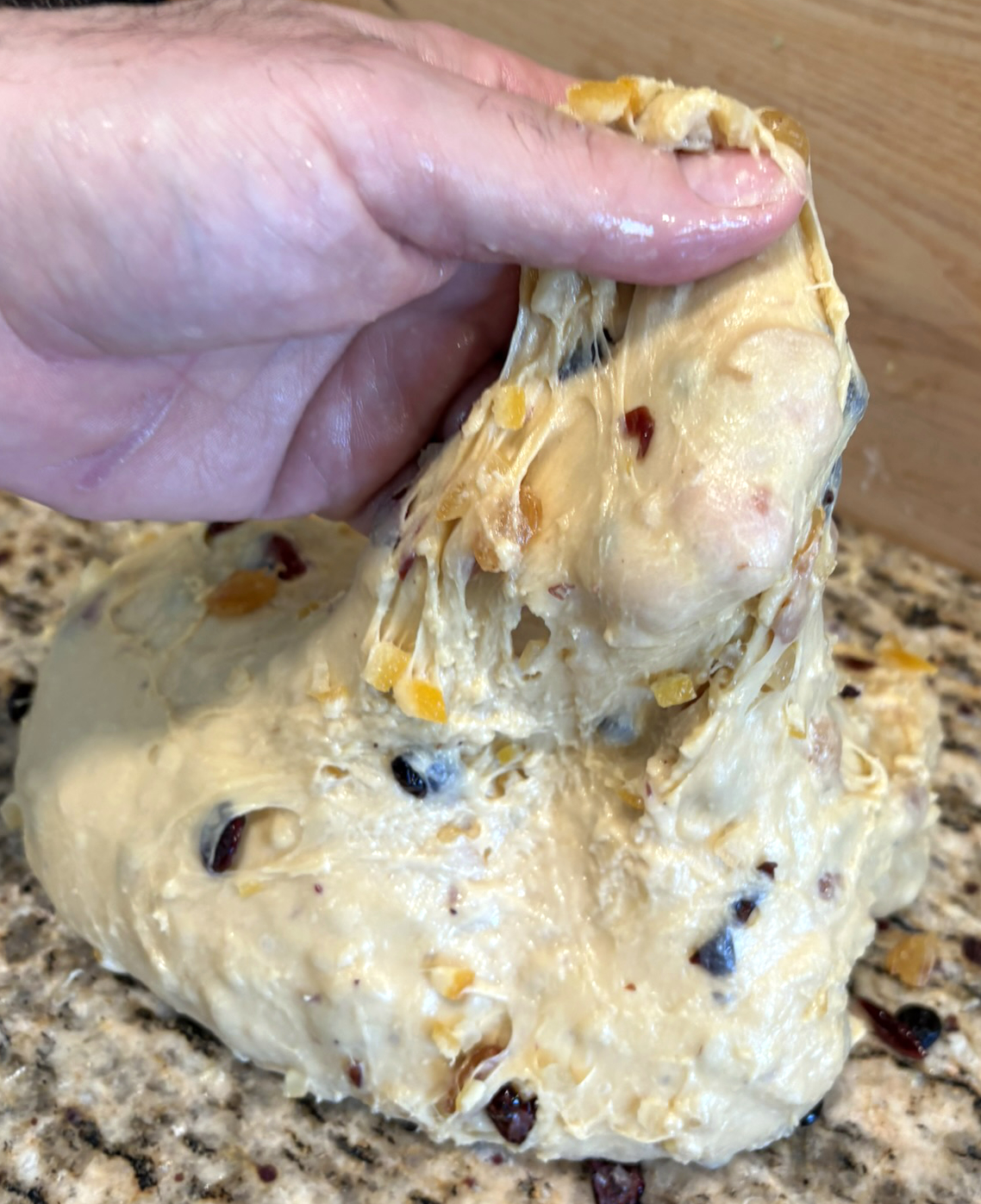
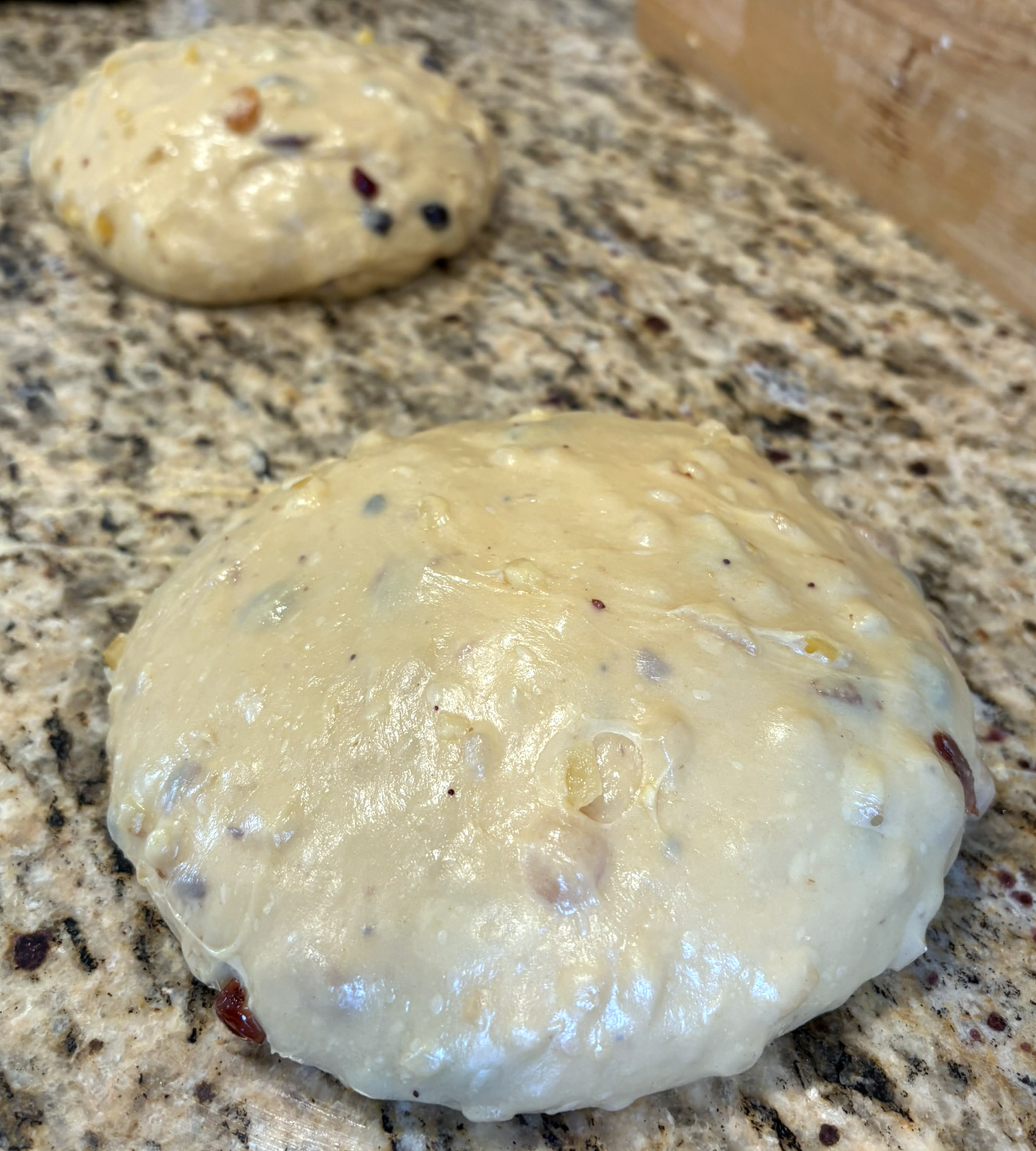
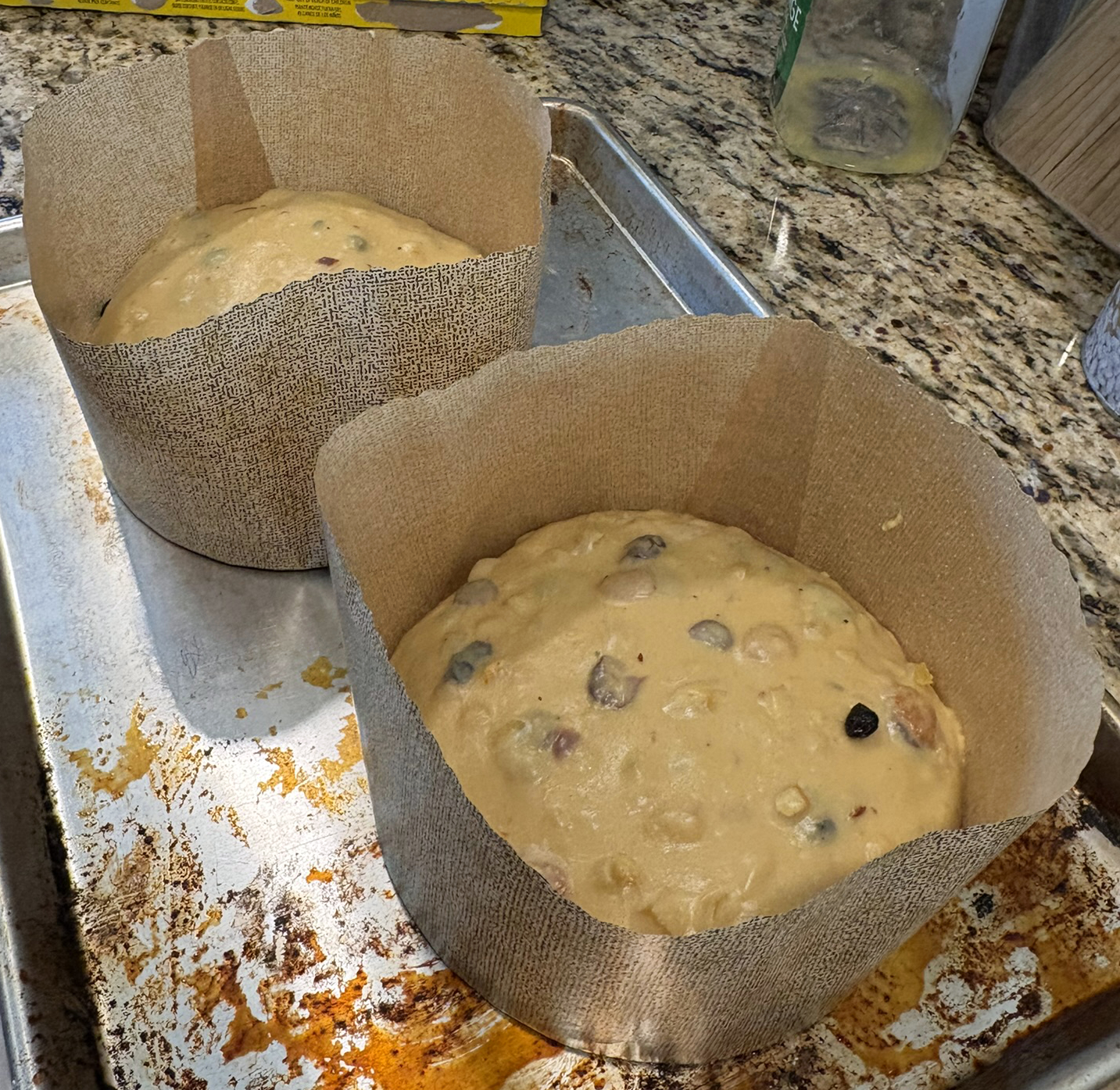
6 hours later there was no discernible rise, so I gave it the full 12, and still nothing. It was now midnight, so I turned the proofing box up 5 degrees to 83F for one more hour, but no change. Easter dinner is now in 26 hours, so out they come and the oven gets preheated to 325F.
Here they are just before I slashed them and put a knob of butter on top.

And an hour later after baking to an internal temp of 205F, I was shocked by the oven spring.
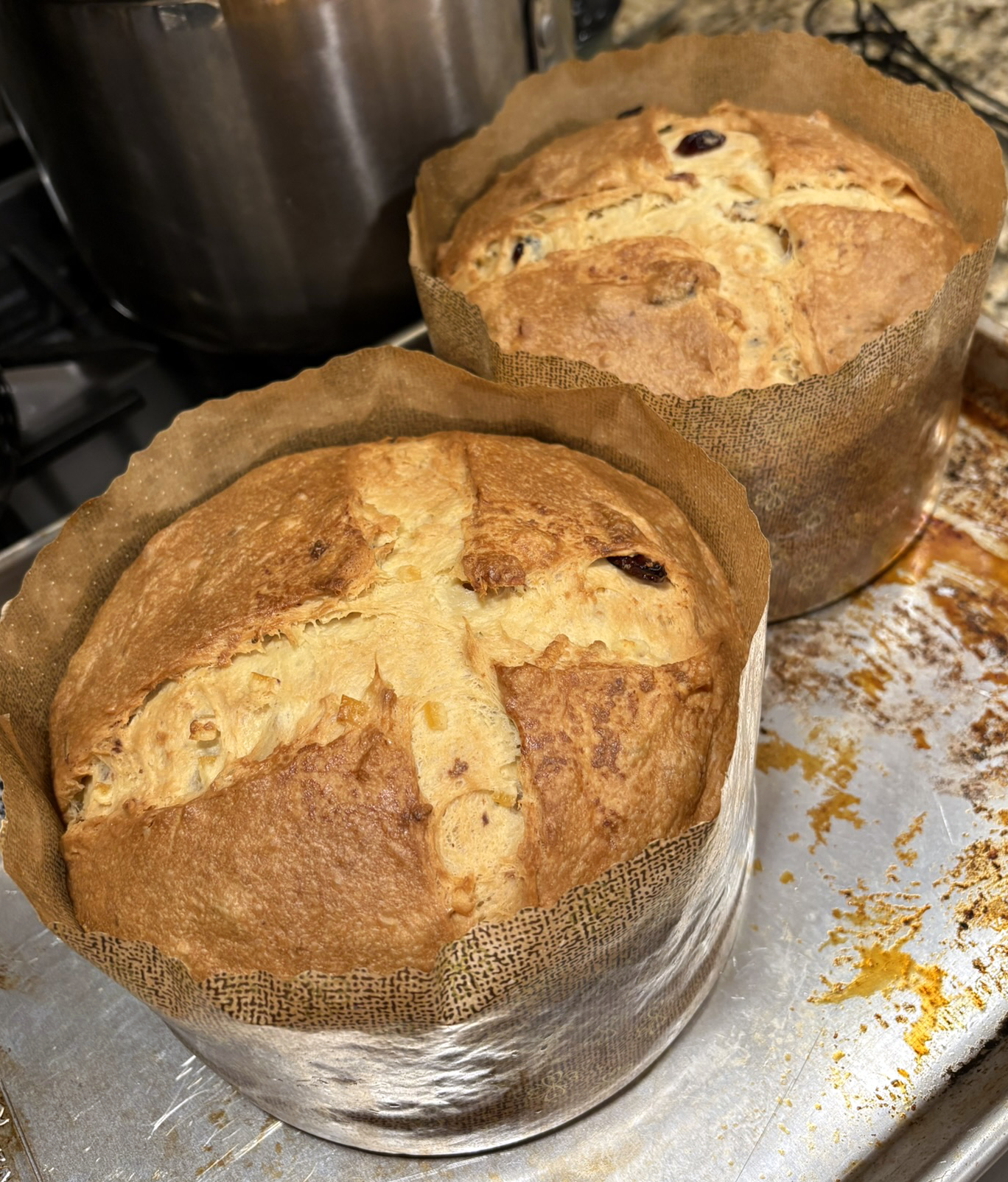
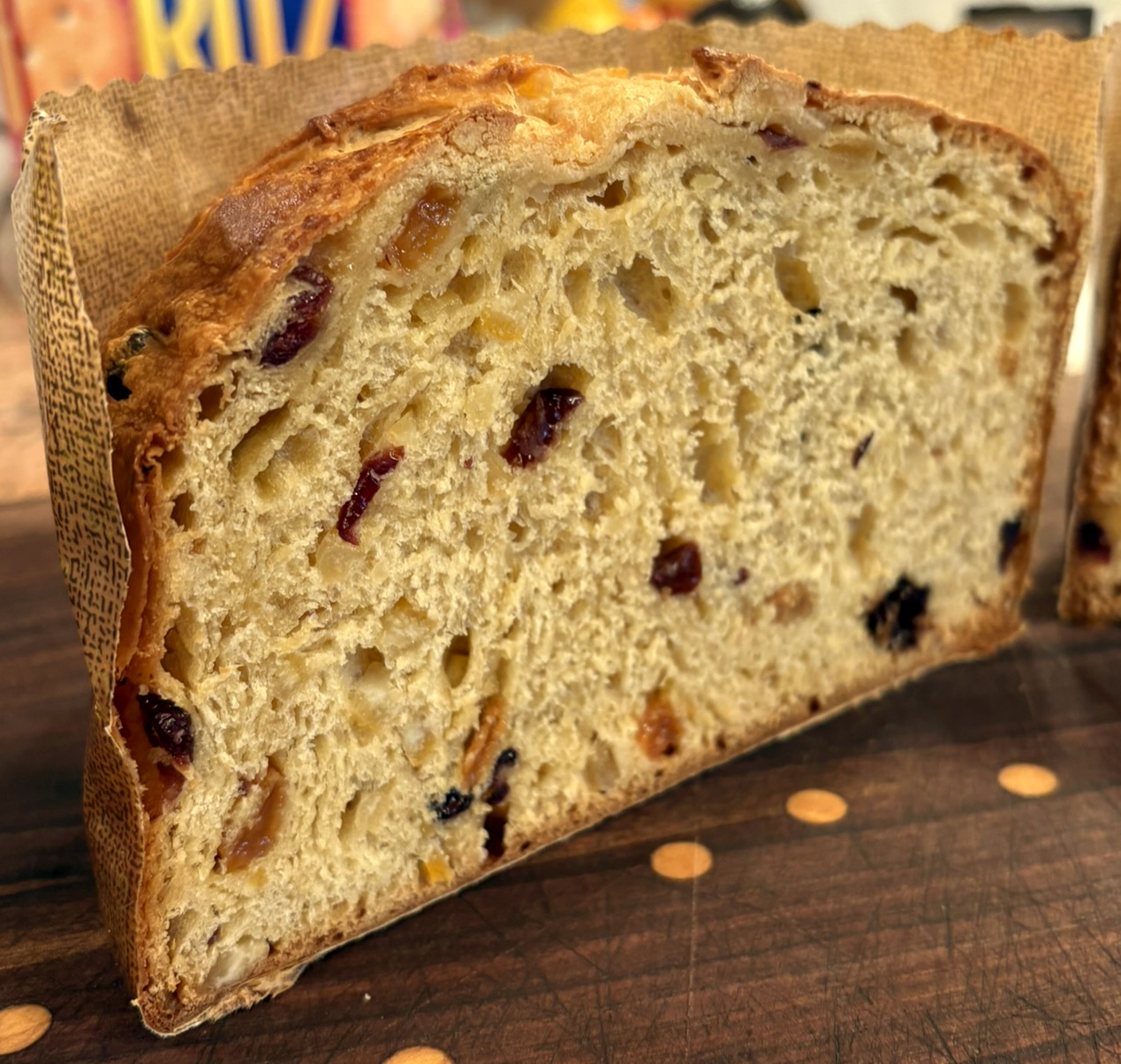
The flavor is exceptional, and the texture is nice, but I am baffled by the total gluten breakdown, and the complete lack of a second rise. I'm clearly doing something wrong, but I can't figure out what it could be.
Thanks for any advice!
Hi, I will look at your ingredient ratios maybe tomorrow, but process-wise, it sounds like you didn’t get gluten developed in the first dough before adding butter and yolks.. Is that correct?
I dissolve the sugar in the water, just takes a couple of minutes stirring. Then add the flour and mix until well incorporated. Usually I give it 10 to 20 minutes autolyse at that point. Then start the mixer and add the starter in small pieces. This is when you need to develop the gluten, fully, which takes different amounts of time depending on the mixer.
You should have a very good windowpane before proceeding to yolk and butter. Also, the dough temperature should not rise above 27C.
Same thing on the second dough. The first dough plus flour should be mixed to windowpane before adding other ingredients.
You are correct. For my previous attempt I did an autolyse with just water and flour, kneaded ~5 minutes and tested for windowpane, only then adding the starter and sugar, kneading another ~5 minutes before adding yolks and butter.
But after watching the video linked above and his perfect results, I decided to follow his method more closely. From his website:
I think I'll go back to my original mixing method, only using his lievito madre method, which seems sound.
Would this have prevented the second rise entirely, though? I don't think my starter could have been any more vigorous, so I'm not sure what would have slowed it down so much. Is 77F not warm enough for the final rise?
And one last question: how does the hydration % look? I feel like my dough looks far wetter than any of the videos I've watched online, but comparing to some other recipes I seem to be in the ballpark.
To me, your water and butter look low. I know you said your hydration seems too high, did you leave out some water you’re putting into the second impasto?
Hi Sue,
I admire your depth of knowledge regarding panettone. I find it really inspiring.
I live in hot place where temperature can get as high as 38 °C (and 29°C at night), I would love to take time to build panettone formula that is designed for such condition, from the ground up, instead of adapting pre-existing available formula, which chances are, would results in too much band-aid approach just to get to finish line.
I had success with Desem fermentation, and would like to up the ante.
A question I'd like to address is, what makes a panettone a panettone (formula wise)? I need to know how far I can deviate from tradition, and still end up with legit panettone
Thanks Sue, appreciate it
Jay
Thank you Sue. No, I didn't leave out any water. Here are the totals with percentages. Perhaps because I didn't develop the gluten properly at first it felt more hydrated than it actually was.
I suppose I'll just have to keep trying! How sad :)
Well, there are the Italian requirements:
But while panettone is an Italian brioche, it’s not required to be made in Italy. Industrial makers are allowed small amounts of yeast, emulsifiers, etc., which are frowned on by artisanal bakers.
Others have tried to make different formulas, either to make it easier for home bakers or to reinvent it entirely, like the Modernist version. But you could invest in a thermoelectric cooler to control the temperatures instead.
So those numbers are not in baker's percentage? Further asks:
Thanks Sue, appreciate it
Jay
– milk and dairy products;
- honey;
– malt;
– cocoa butter;
– sugars;
– yeast having the requirements set out in art. 8 of Presidential Decree 30 November 1998, n. 502, up to the limit of one percent (1%);
– natural flavours [the original extension to the use of 'natural identical' flavourings was abolished with the elimination of this category with the Food Improvement Agents Package, Regulations (EC) 1331-1334/08, ed.];
– emulsifiers;
– the preservative sorbic acid;
– preservative potassium sorbate'.
2. You should read and understand the concepts behind sugar saturation as it affects fermentation, see Chambelland’s book.
Beyond a certain point of sugar saturation, fermentation slows significantly.
3. Open crumb in panettone is more complex than it is for bread, due to the balancing of ingredients required. Best to find an established recipe that you admire and adjust it over time.
Thanks Sue, appreciate it
I'm interested in that Chambelland's reference. It's just I wish there is a way I could demonstrate how vigor my bran-skim milk starter is right now. After making tiny levain (2:4:2:1 starter:flour:water:sugar) it matured in 3 hours with lag phase only 1 hour. However, It's not as tolerant to butter.
There is one formula I like, and I think you are right, I will start from there and making tweaks along the way.
I just have one remaining question if you don't mind, the youtube video I like is in Italian, when a levain is referred as pasta madre, how low hydration can go/ be allowed?
Thanks Sue, I look forward to practice panettone
Jay
There is a reason why panettone is called the Mount Everest of baking. It's not an easy journey. Every time you learn something.
Every experienced panettone baker says that if something goes wrong in 80% of the cases it's the Lievito Madre. In the rest (or at least 80% of the rest) of the cases it's the gluten. After a few kg of panettone flour I must admit that they are right.
A few things that I noticed:
The LM maintenance in the water is more difficult than the dry method. Without a very good reason I would always use the dry method.
The 3 warm refreshments before mixing the primo are imo a bit odd. The ratios starter:flour are 1:2, 1:0.83, 1:0.59, but the times and the temperatures are the same. For the ratio 1:2 at 80F/26ºC the 4h might be on the short side, but for sure not far from ideal (4.5h, depending on how warm the LM was after mixing). For all other ratios 4h is imo too much. The LM is at the end probably too lactic.
I never mix the primo until it shows a good (thin) windowpane. I stop mixing as soon as the gluten structure is developed, but the dough is still a bit stiff. The dough sticks a bit to the bowl, but detaches when you pull. A thick windowpane is possible.
The primo doesn't look too happy to me. Did it really triple in volume? It might be a bit too lactic. I'm also wondering what is the (liquid) fat above the dough. Was the butter too warm and started melting?
There is no such thing as "room temperature" when it comes to panettone.
Butter temperature - all recipes I've seen mention 16º-18ºC. I usually use colder butter, otherwise my dough is at the end too warm. But not too cold. Just warm enough to keep its plasticity.
Core temp 205F (96ºC) is imo a bit to high for panettone. It's too dry. Good if you want to increase the shelf life. Otherwise I'd go for 92ºC.